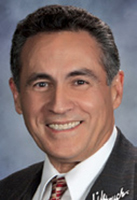
Executive Perspective
An Old Challenge But New Opportunity for Equity
By Daniel A. Domenech/
School Administrator, May 2017

Winston Churchill said, “Never let a good crisis go to waste.”
There is much hand wringing and worrying going on about the future of public education under the current administration in Washington, D.C. There are concerns about a likely push to privatize public education via privately managed charters and choice and that vouchers will be issued to allow families to send their children to privately operated schools.
None of these ideas is a new challenge for public education. What is new, and very much a major concern to educators, is that the current administration may reallocate dollars from the education budget to fund these activities at the expense of existing programs.
An Ongoing Test
This is a new chapter in the anti-public education battle that we have been fighting for years. Irrespective of the facts, we continue to hear how bad our schools are even though they are better today than they have ever been. There are 50.4 million students enrolled in 98,300 public schools across America. Charter schools enroll 2.5 million students in 6,465 schools, according to the latest U.S. Education Department statistics. Although there are many exceptional charter schools providing a quality education for the students they serve, there are many more exceptional public schools providing exceptional quality education.
The challenge our public schools have been facing for years is the lack of equity based on how our schools are funded. Public schools in wealthy communities receive much more funding than public schools in economically deprived areas. The Elementary and Secondary Education Act passed in 1965 and its new iteration, the Every Student Succeeds Act, are attempts by the federal government to equalize the playing field by providing federal funds to impoverished schools. When there are cutbacks in federal funding, as we have seen recently through sequestration, it is the schools that can least afford it that feel the pain. If federal funds were to be reallocated to fund charter schools, vouchers and choice, it would be the poorest schools in the country that would lose funding to benefit a much smaller portion of the student population.
Our wealthy suburban school districts arguably are among the best school systems in the country. According to the Pew Research Center, only 19 percent of students from urban school districts seek higher education compared to 70 percent from suburban districts. This is not surprising when you consider the disparity in per-pupil spending.
On average, 45 percent of a district’s revenue comes from local real estate taxes with another 45 percent from the state and 10 percent from the federal government. In a wealthy community, the federal contribution will be less than 2 percent while federal support in a poor school system may exceed 50 percent. Wealthy communities will continue to spend more on their students. Consequently, federal support will never rise to the level where all systems will be spending equal amounts per pupil.
Breaking Molds
So, back to Churchill’s premise. Is there an opportunity in this current environment to advance equity and provide a quality education for all of our students? We think so.
AASA is working with hundreds of superintendents nationwide who are implementing highly innovative and academically successful programs for the students they serve. Many of these programs have broken the traditional mold and use blended learning in nongraded, personalized learning environments. Often these schools must obtain waivers from existing rules and regulations. An incentive for establishing a charter school is the opportunity to be innovative and be granted waivers from rules and regulations.
Most of the districts we are working with have established alternative pathways for their students. Rather than having all students follow the same path to a high school diploma, these districts offer choices. Many also are redefining what it means to be ready for college and career. Early college programs and dual enrollment leading to graduating high school with an associate’s degree are options offered by an increasing number of districts. They work cooperatively with businesses and community colleges to provide students with the skills they need through internships and apprenticeships to fill jobs that do not require a four-year college degree.
A multitude of exciting and innovative programs are going on in our public schools. In doing so, they are breaking down the economic barriers and offering all of our students the opportunity to succeed. Charters, vouchers and choice can be great enablers as long as they remain part of the public education system, not as alternatives to it.
Daniel Domenech is AASA executive director. E-mail:
ddomenech@aasa.org. Twitter:
@AASADan